I was pretty serious about that 250 watt. That's what it would take to get me to the limit of x-max on my line arrays. But I'm not sure to buy just any amplifier. And with some experiments involving series resistors I might need even more power.
I'll continue using my trusty old Pioneer A 757 Mark II for now but know it will be the first limiting factor.
I was just curious if there were any good full range amps out there with good reviews and lots of power. I had looked at PA amps and might even try one some day. But I want to be sure I use a good one, even if it is cheap, it still has to be good.
Dual amps might even be the better solution for me.
I'll continue using my trusty old Pioneer A 757 Mark II for now but know it will be the first limiting factor.
I was just curious if there were any good full range amps out there with good reviews and lots of power. I had looked at PA amps and might even try one some day. But I want to be sure I use a good one, even if it is cheap, it still has to be good.
Dual amps might even be the better solution for me.
Last edited:
I was pretty serious about that 250 watt. That's what it would take to get me to the limit of x-max on my line arrays. But I'm not sure to buy just any amplifier. And with some experiments involving series resistors I might need even more power.
I'll continue using my trusty old Pioneer A 757 Mark II for now but know it will be the first limiting factor.
I was just curious if there were any good full range amps out there with good reviews and lots of power. I had looked at PA amps and might even try one some day. But I want to be sure I use a good one, even if it is cheap, it still has to be good.
Pro amps have just about the best Watt to dollar ratio if you need a lot of power. Just be careful of fan noise with the PA amps. And if you're using a receiver as a preamp then the high input sensitivity will likely be a problem.
The Crown XLS tick a lot of the right boxes for home use, but I'm sure there are many other good or better ones.
I looked at the excursion just now in that sim and 50W may be enough power because the dayton hits xmax really fast.
I think you have a BW1 high pass filter set right? With a BW1@25Hz the woofer hits 7mm with just 30W and 90db after baffle step
My fo is 51Hz with Q=0.61 for 24 liters
The LT is for 30Hz goal with Q-0.71, requires about 9dB boost
I am actually using a 29Hz BW2 high pass infrasonic filter
I don't have LT modeled yet but your numbers look reasonable - I am pretty sure I get more than 90dB though - maybe 94dB?
My fo is 51Hz with Q=0.61 for 24 liters
The LT is for 30Hz goal with Q-0.71, requires about 9dB boost
I am actually using a 29Hz BW2 high pass infrasonic filter
I don't have LT modeled yet but your numbers look reasonable - I am pretty sure I get more than 90dB though - maybe 94dB?
With a 2nd order filter, I'm sure you do get more spl. I actually had the hp set at 30Hz not 25 though. Remember that this is for the 4ohm dayton, so it's not really that aplicable, but I already that driver saved. Ill do one for the 8ohm in a little bit with your coefficients
Do you want actual biquad coefs used? I think I gave you everything you need to generate the transform: native f0=51Hz with Q=0.61 LT to get f=30Hz with Q=0.71.
Do you want actual biquad coefs used? I think I gave you everything you need to generate the transform: native f0=51Hz with Q=0.61 LT to get f=30Hz with Q=0.71.
Yeah, sorry I forgot about those
Ok, first of all I get a Q of .676 in 24L and an fc of 54.5 with moderate stuffing. 30L gives an fc of 51Hz Q=.63. I ran the sim for your box though.
It hits xmax at 30Hz with an input power of 14W. You only need 25W from your amp to do this, but have an xmax limited output of 97db before baffle step, so 91db with full baffle step. This takes 9db of boost before the high pass is applied. Keep in mind that this isn't music power and depending on the music there may not be much content at 30Hz so you can probably play it louder in practice.
If it was me, I probably wouldn't be trying to push a single sealed 8" that low because output seems a little limited. You should be more than happy with an f3 or 40-45Hz and maybe you can drop the highpass. You would still have usable output in the 30's inroom like this. Plus less group delay, distortion and more output headroom for safety sake.
It hits xmax at 30Hz with an input power of 14W. You only need 25W from your amp to do this, but have an xmax limited output of 97db before baffle step, so 91db with full baffle step. This takes 9db of boost before the high pass is applied. Keep in mind that this isn't music power and depending on the music there may not be much content at 30Hz so you can probably play it louder in practice.
If it was me, I probably wouldn't be trying to push a single sealed 8" that low because output seems a little limited. You should be more than happy with an f3 or 40-45Hz and maybe you can drop the highpass. You would still have usable output in the 30's inroom like this. Plus less group delay, distortion and more output headroom for safety sake.
The fs and Q were measured with impedance sweep. I agree 30Hz probably too low but gives nice effect for low SPL. Original goal was 41Hz after LT. What would max SPL be for 41Hz goal?
The fs and Q were measured with impedance sweep. I agree 30Hz probably too low but gives nice effect for low SPL. Original goal was 41Hz after LT. What would max SPL be for 41Hz goal?
I figured yours were probably right. These are using PE's T/S so.... They may not even be the same as what Dayton lists; I've noticed a lot of that between Dayton and Parts Express. Very confusing.
I did sim with your box volume so the xmax figures should be pretty accurate. Especially because I ended up with the same amount of boost as you, 9db
The fs and Q were measured with impedance sweep. I agree 30Hz probably too low but gives nice effect for low SPL. Original goal was 41Hz after LT. What would max SPL be for 41Hz goal?
101 with BW2 HP at 29Hz, before baffle step. 98 without HP, but you get more low end and less group delay.
But...the goal of 30 with Hp and goal of 41 without HP both provide an f6 of 31Hz with the 41Hz goal giving slightly higher max output. F6 or F10 is really a more useful number in room, so they both provide basically the same bass. The 41Hz goal actually has a lower f10
These are simed for 7mm xmax, some people use xmax plus 10 or 15%, so with that spl would be a little higher
Some more measurements with TDA7492
Now running the new TDA7492 amps which sound really dynamic to my ears. I am highly recommend these cheap $8 amps and $5 mods. I removed the infrasonic HPF per SATX's recommendation, and the bass is indeed deeper and the transients sound better with inproved group delay. The HPF allowed cleaner lower distortion bass and a bit more power but there was not much content down there anyway while the GD suffered. Listening to it now, the sound is much more alive and realistic. The measurements show an improved GD that is within +/-2.5ms above 32Hz. But more importantly, the step response is starting to look a little more like a triangle and this is audible as a more realistic presentation of stand up bass and kick drums. I sat there and listened to two full CD's of jazz with drums and stand up plucked bass. Sounds fantastic! The reach of the bass now really gives some body to the sound.
Here is the measured response (super smoothed to see where acoustic xo is located), and to see effect of HPF. This shows the individual speaker (left& right) measured responses at 0.5m overlaid on top of one another to check for parity between speakers (HF, LF, and combined). Without the HPF, the f3 is around 32Hz:
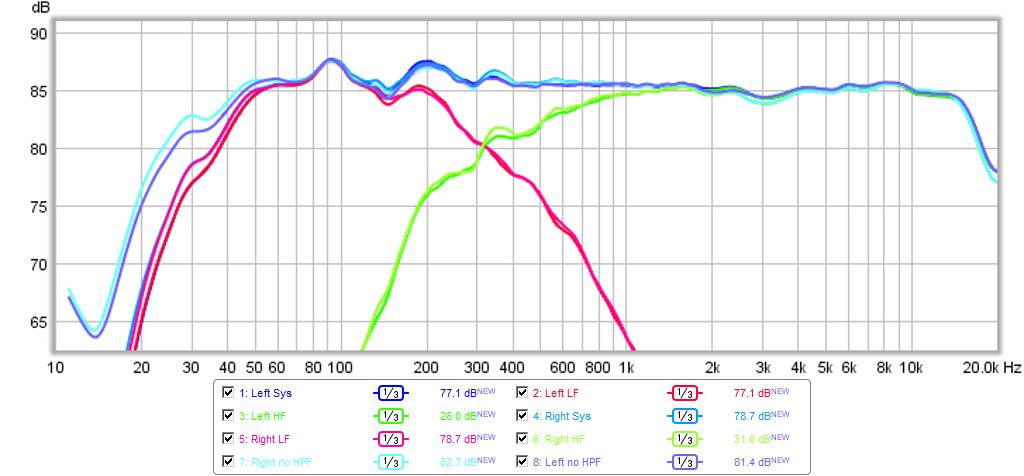
Here is the measured absolute and minimum phase. There are no phase wraps above 100Hz which is good. I measured a wrap at 1kHz on the left speaker yesterday and that may have been caused by stray inductance near the speaker cable which I cleaned up:
Left
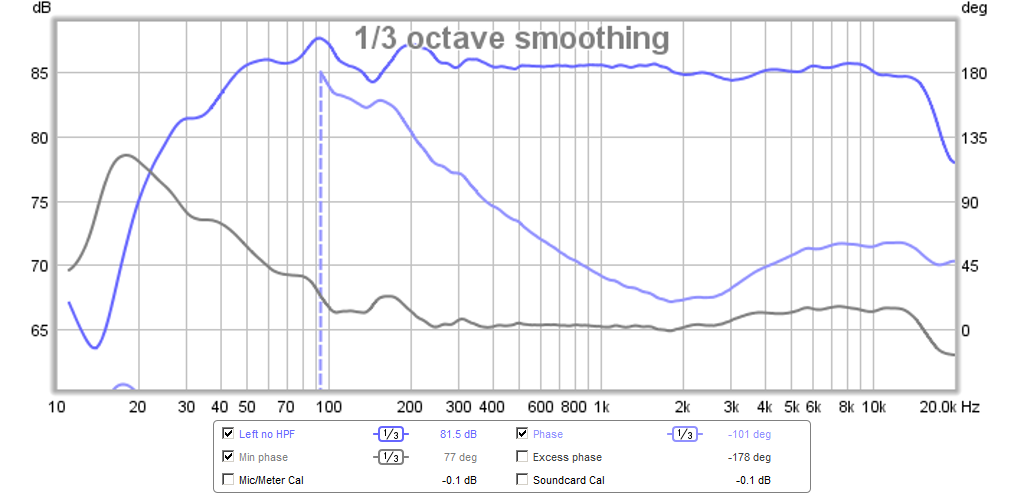
Right

Here is the measured impulse response and step response for each side:
Left
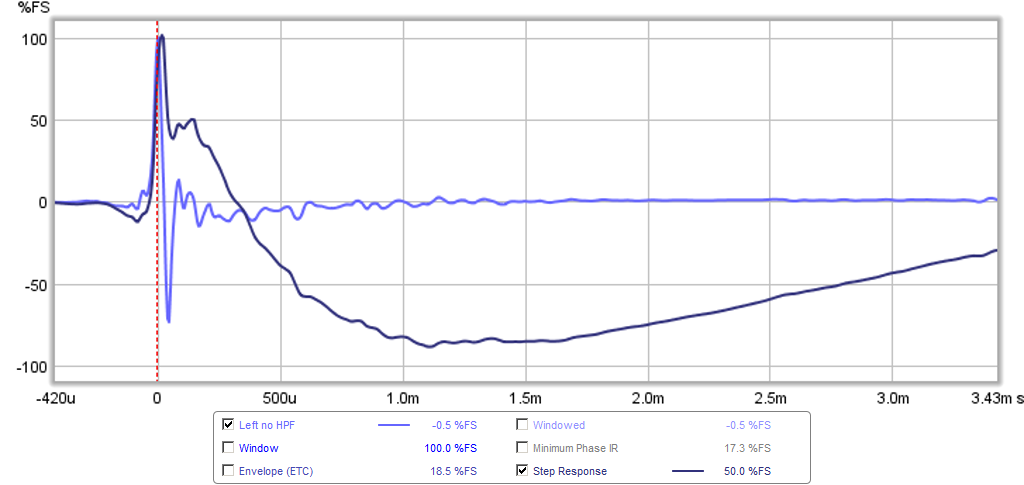
Right
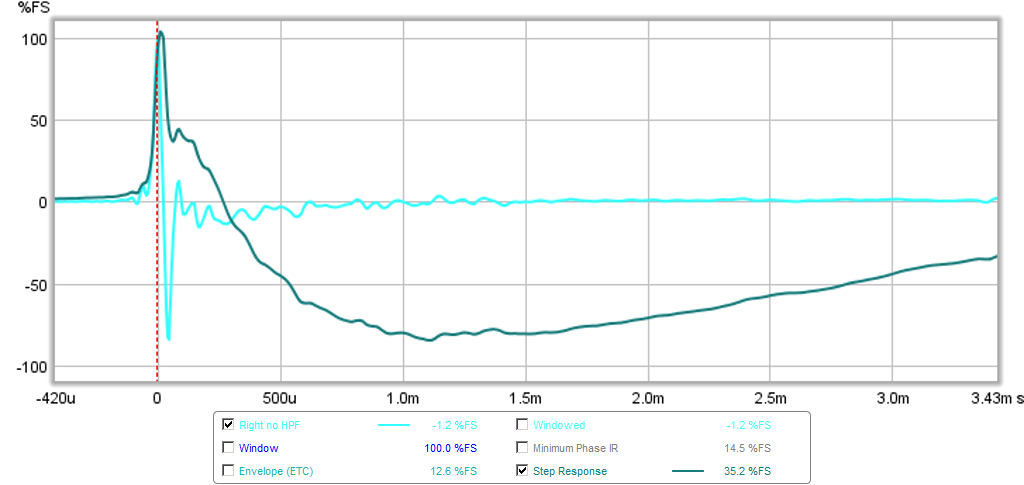
Here is the measured group delay for each side:
Left
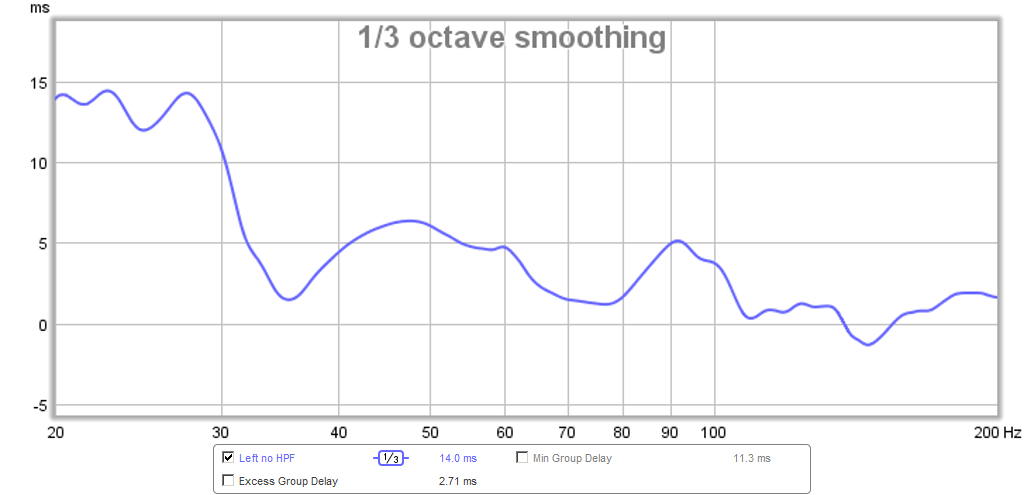
Right
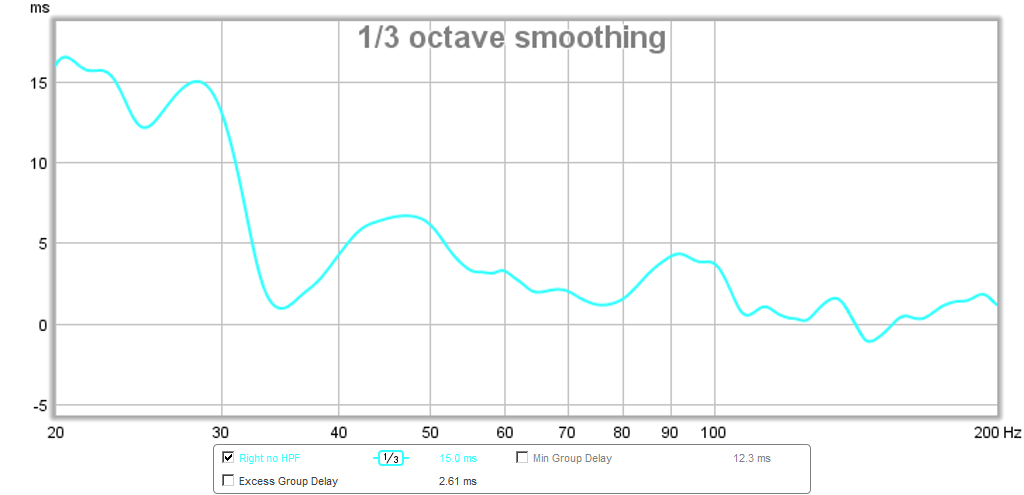
Overall, I think a pretty nice result and I double checked my listening levels at the listening position is 85dB with both speakers, so individually, I am running them at 83dB at the LP which is about 2m away. So actual SPL's at 1m are 89dB per speaker - still within range of reasonably low harmonic distortion numbers. The speakers are extremely well balanced left and right and I think this helps to give an excellent stereo image and solid sound stage. I can place the instruments in the jazz ensemble very well with eyes closed. I am going to lock down this config for a while and just enjoy listening to it. 🙂
Now running the new TDA7492 amps which sound really dynamic to my ears. I am highly recommend these cheap $8 amps and $5 mods. I removed the infrasonic HPF per SATX's recommendation, and the bass is indeed deeper and the transients sound better with inproved group delay. The HPF allowed cleaner lower distortion bass and a bit more power but there was not much content down there anyway while the GD suffered. Listening to it now, the sound is much more alive and realistic. The measurements show an improved GD that is within +/-2.5ms above 32Hz. But more importantly, the step response is starting to look a little more like a triangle and this is audible as a more realistic presentation of stand up bass and kick drums. I sat there and listened to two full CD's of jazz with drums and stand up plucked bass. Sounds fantastic! The reach of the bass now really gives some body to the sound.
Here is the measured response (super smoothed to see where acoustic xo is located), and to see effect of HPF. This shows the individual speaker (left& right) measured responses at 0.5m overlaid on top of one another to check for parity between speakers (HF, LF, and combined). Without the HPF, the f3 is around 32Hz:

Here is the measured absolute and minimum phase. There are no phase wraps above 100Hz which is good. I measured a wrap at 1kHz on the left speaker yesterday and that may have been caused by stray inductance near the speaker cable which I cleaned up:
Left

Right

Here is the measured impulse response and step response for each side:
Left

Right

Here is the measured group delay for each side:
Left

Right

Overall, I think a pretty nice result and I double checked my listening levels at the listening position is 85dB with both speakers, so individually, I am running them at 83dB at the LP which is about 2m away. So actual SPL's at 1m are 89dB per speaker - still within range of reasonably low harmonic distortion numbers. The speakers are extremely well balanced left and right and I think this helps to give an excellent stereo image and solid sound stage. I can place the instruments in the jazz ensemble very well with eyes closed. I am going to lock down this config for a while and just enjoy listening to it. 🙂
Attachments
-
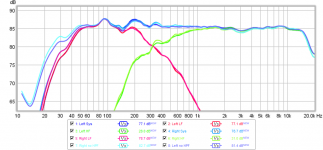 10f-rs225-fast-tda7492-xo.png94.7 KB · Views: 1,655
10f-rs225-fast-tda7492-xo.png94.7 KB · Views: 1,655 -
 10f-rs225-fast-tda7492-left-phase.png83.9 KB · Views: 1,275
10f-rs225-fast-tda7492-left-phase.png83.9 KB · Views: 1,275 -
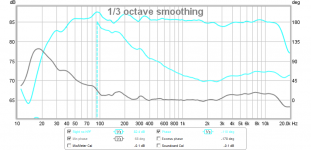 10f-rs225-fast-tda7492-right-phase.png80.8 KB · Views: 697
10f-rs225-fast-tda7492-right-phase.png80.8 KB · Views: 697 -
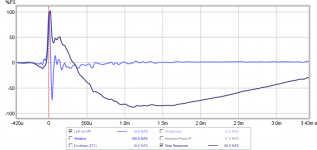 10f-rs225-fast-tda7492-left-ir.png62.2 KB · Views: 699
10f-rs225-fast-tda7492-left-ir.png62.2 KB · Views: 699 -
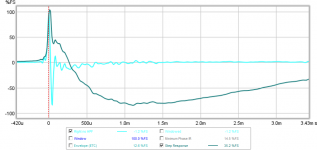 10f-rs225-fast-tda7492-right-ir.png60.3 KB · Views: 693
10f-rs225-fast-tda7492-right-ir.png60.3 KB · Views: 693 -
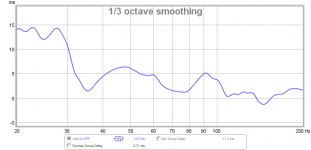 10f-rs225-fast-tda7492-left-gd.png43.4 KB · Views: 670
10f-rs225-fast-tda7492-left-gd.png43.4 KB · Views: 670 -
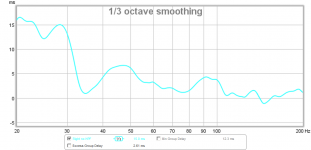 10f-rs225-fast-tda7492-right-gd.png42 KB · Views: 672
10f-rs225-fast-tda7492-right-gd.png42 KB · Views: 672
Last edited:
I'm glad you solved the phase wrap. With speakers this close to each other in output the stereo imaging is going to be very good!
Did you measure up close? Have you tried measuring at the listening position?
Did you measure up close? Have you tried measuring at the listening position?
I measured the above at 0.5m in front of each speaker individually. I haven't measured at LP recently but recall an effect of room modes and floor bounce. Obviously it won't be as flat below 500Hz but the HF's were very similar to the 0.5m data. I'll do a measurement at LP in the coming days and see how it looks.
The HPF allowed cleaner lower distortion bass and a bit more power but there was not much content down there anyway while the GD suffered.
This is probably what causing the phase problem in the lower bass. I forgot if Linkwitz has ever mentioned this HPF in his LT implementation. You can create a clip (such as the Norah Jones) to see if the problem is fixed.
I actually didn't say to remove the Hp. Taking the HP off with 9db of eq at 30Hz is probably not a good idea. What I said is that if you move the target to an f3 of around 40Hz you can remove the HP and get pretty much the same bass response, less group delay and slightly higher max output(headroom)
as it is now anywhere below 35Hz you exceed xmax @90db. The amp also starts needing more juice than you can provide.
It's not really a good idea to design in such a way that you're almost pushing the limits of your speaker when you're at your normal listening levels.
as it is now anywhere below 35Hz you exceed xmax @90db. The amp also starts needing more juice than you can provide.
It's not really a good idea to design in such a way that you're almost pushing the limits of your speaker when you're at your normal listening levels.
I actually didn't say to remove the Hp. Taking the HP off with 9db of eq at 30Hz is probably not a good idea. What I said is that if you move the target to an f3 of around 40Hz you can remove the HP and get pretty much the same bass response, less group delay and slightly higher max output(headroom)
as it is now anywhere below 35Hz you exceed xmax @90db. The amp also starts needing more juice than you can provide.
It's not really a good idea to design in such a way that you're almost pushing the limits of your speaker when you're at your normal listening levels.
I will see if I can get the LT to aim for 40Hz, but I know that is going to make the bass sound less full. It is kind of moving a lot but there is xmax and xmech which is far greater. It sounds really convincing though, xmax limit notwithstanding...
I will see if I can get the LT to aim for 40Hz, but I know that is going to make the bass sound less full. It is kind of moving a lot but there is xmax and xmech which is far greater. It sounds really convincing though, xmax limit notwithstanding...
You don't have to move it of course. Do whatever sounds best to you. I was just clarifying because you seemed to have misunderstood me.
The sims show the bass being pretty much identical with 30hz+HP and 38Hz+no HP. with the higher target actually having a lower f10. Also, you gain a little max spl.
I understand that there are differences between xmax and xmech and you are not likely to bottom the driver at your listening level. But, more excursion, more distortion, especially past xmax. Plus why would you want to never be able to crank it up without fear of damage?
- Home
- Loudspeakers
- Full Range
- 10F/8424 & RS225-8 FAST / WAW Ref Monitor